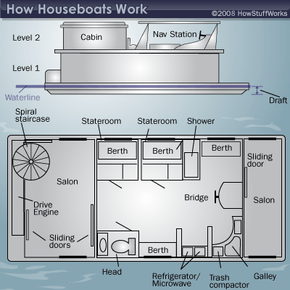Day-to-day Living on Houseboats
Although the purpose of a houseboat is similar to any other shelter on land -- to provide us with a place to live and sleep and store our food and belongings -- living aboard is a much different experience. At their most basic level, common houseboats offer modest living space even when compared to apartment-sized dwellings. Unless they are state-of-the-art and very expensive, they won't have many of the same conveniences that houses on land do, such as several stories or lots of storage space.
Just as there are different names certain sections of a houseboat, there are also different names for the rooms. Here are the basic areas in a houseboat:
Advertisement
- Berth - the bed. If the bed is located at the bow of the boat, where the shape of the structure usually makes a "V" shape, the bed is called a V-berth.
- Stateroom - the bedroom
- Galley - the kitchen
- Head - the bathroom
- Cabin - a place where passengers can meet. A living room is also known as the salon.
- Cockpit - the place where the boat is steered, also known as the bridge. The helm is the specific steering station.
- Nav station - the place where navigation equipment is located, necessary for bluewater houseboats. This is where the boat's radio, charts and GPS will be.
Everyone's needs are different, but the above rooms are the kinds you'll find in most dwellings, whether they're on land or above the water. The navigation station and equipment are necessary additions to cruising houseboats since they move about the water and their owners need to chart positions and be ready for emergencies.
But how can something like a kitchen or a toilet work when the house is floating on water? Non-cruising houseboats are similar to houses on land in this respect -- they're simply hooked up to a direct source of water and sewage treatment. Known as a "water hookup," an external hose brings in "city water," or water from any fresh-water system, directly onto the boat. A separate sewage line will suck sewage directly from the boat's head away from its location in the same fashion a regular house would experience.
If the houseboat is of the cruising variety, additions usually need to be made -- a water tank for drinking, showering and washing, and a separate sewage tank, or holding tank, for waste. A head can either be electric, of the same type you normally see in a regular house, or manual, which usually requires pumping a handle to flush. There are many options available for disposing of waste aboard a cruiser -- some systems can treat waste and are allowed to pump it off of the boat, while some heads incinerate sewage into ash and can legally dispose of it into the water.
Electricity can be provided in several ways. Non-cruising houseboats hook up directly to shore power provided by marinas. Cruising houseboats might use generators or rechargeable batteries. If they use batteries, one needs to be available for the engine, while an additional one will be used for any other source of power. Many boaters will have amperage and volt readers to monitor the amount of power available during trips -- running water, refrigeration, flushing electric toilets or watching satellite television will use power, and being stranded without electricity in the middle of the sea could cause problems.
To read about the physics of staying afloat on a houseboat, read the next page.
